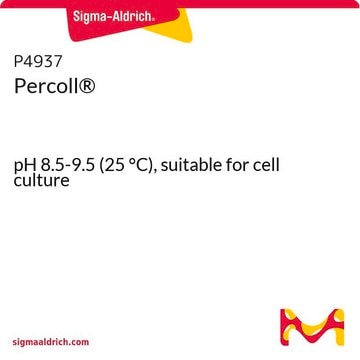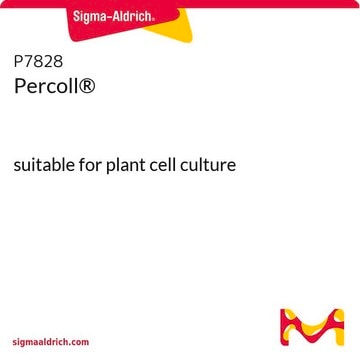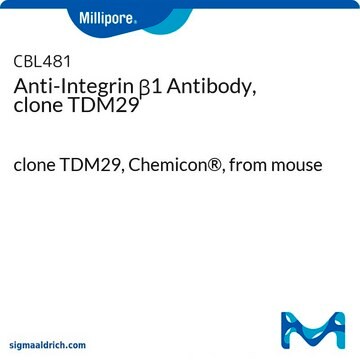P1644
Percoll®
pH 8.5-9.5 (20 °C)
Synonym(s):
Percoll Density Gradient Media
Sign Into View Organizational & Contract Pricing
All Photos(1)
About This Item
Recommended Products
sterility
aseptically filled
Quality Level
color
clear colorless to faint yellow
pH
8.5-9.5 (20 °C)
application(s)
hematology
histology
storage temp.
2-8°C
Looking for similar products? Visit Product Comparison Guide
General description
Percoll® is a classic medium for density gradient centrifugation of cells, viruses, and subcellular particles. Percoll consists of colloidal silica particles of 15–30 nm diameter (23% w/w in water), which have been coated with polyvinylpyrrolidone (PVP). The PVP coating renders the product completely non-toxic and ideal for use with biological materials.
Application
Percoll consists of colloidal silica particles of 15-30 nm diameter (23% w/w in water) which have been coated with polyvinylpyrrolidone (PVP). It is used to establish non-toxic low viscosity, low osmolarity density gradients that can be used to isolate cells, organelles and viruses. It has been used to separate inner and outer membrane vesicles from E. coli. Percoll is isosmotic throughout the gradient, non-toxic, and is easily removed from the purified materials.
Percoll® has been used in sperm preparation to study the energy requirements of bovine embryos.
Legal Information
Percoll is a registered trademark of Cytiva
related product
Product No.
Description
Pricing
Storage Class Code
10 - Combustible liquids
WGK
WGK 3
Flash Point(F)
Not applicable
Flash Point(C)
Not applicable
Personal Protective Equipment
dust mask type N95 (US), Eyeshields, Gloves
Certificates of Analysis (COA)
Search for Certificates of Analysis (COA) by entering the products Lot/Batch Number. Lot and Batch Numbers can be found on a product’s label following the words ‘Lot’ or ‘Batch’.
Already Own This Product?
Find documentation for the products that you have recently purchased in the Document Library.
Customers Also Viewed
Noa Bossel Ben-Moshe et al.
Nature communications, 10(1), 3266-3266 (2019-07-25)
Complex interactions between different host immune cell types can determine the outcome of pathogen infections. Advances in single cell RNA-sequencing (scRNA-seq) allow probing of these immune interactions, such as cell-type compositions, which are then interpreted by deconvolution algorithms using bulk
Development of bovine embryos in vitro as affected by energy substrates.
Rosenkrans Jr C F, et al.
Biology of Reproduction, 49(3), 459-462 (1993)
Tanja Zöller et al.
International journal of molecular sciences, 19(3) (2018-03-02)
Microglia are the resident immune cells of the central nervous system (CNS) and participate in physiological and pathological processes. Their unique developmental nature suggests age-dependent structural and functional impairments that might contribute to neurodegenerative diseases. In the present study, we
Guilherme D Melo et al.
Scientific reports, 7(1), 8454-8454 (2017-08-18)
Visceral leishmaniasis (VL) is a systemic disease with multifaceted clinical manifestations, including neurological signs, however, the involvement of the nervous system during VL is underestimated. Accordingly, we investigated both brain infection and inflammation in a mouse model of VL. Using
Rajasree Sreedharan et al.
Kidney international, 86(3), 515-524 (2014-05-09)
Inducible heat shock proteins (HSPs), regulated by heat shock factor-1 (HSF-1), protect against renal cell injury in vitro. To determine whether HSPs ameliorate ischemic renal injury in vivo, HSF-1 functional knockout mice (HSF-KO) were compared with wild-type mice following bilateral
Our team of scientists has experience in all areas of research including Life Science, Material Science, Chemical Synthesis, Chromatography, Analytical and many others.
Contact Technical Service










